Recommended Low Maintenance Shade Trees for Lake County
PRINTABLE VERSION -
Recommended Low Maintenance Shade Trees for Lake County List
SMALL SHADE TREES
There are many beautiful low maintenance shade trees that are suited to
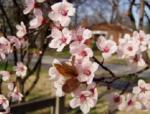
The golden rain tree (Koelreuteria paniculate) pictured below, is a slow growing, small tree that will not exceed 25-35’ maximum. It tolerates poor, alkaline soils common in this area, is heat, cold and drought tolerant, good in lawns, has non-invasive roots and pretty yellow flowers.
The purple-leaf plum (Prunus cerasifera) (pictured above), is generally considered a garden tree. It is a fast-growing, deciduous tree that grows to heights of 25’ and spreads of 15-25’.
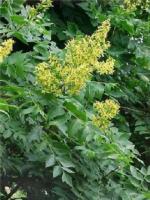
Western redbud (Cercis occidentalis) – deciduous, 6-20', native, drought tolerant, deer resistant, magenta spring flowers.
Crape myrtle (Lagerstroemia indica) – deciduous, 30', slow growing, hardy, drought tolerant, showy summer flowers of white, pink, fuchsia, lavender, red, or violet, fall colors of bronze, orange and red.
Toyon(Heteromeles arbutifolia) – evergreen, 6-15', native, drought tolerant, shrub/ tree, white summer flowers, winter red berries.
Amur maple (Acer ginnala) – deciduous, 20-30', moderate growth, pest free, tolerates most soils, good small garden tree, red fall color.
MEDIUM SHADE TREES
These tress grow 30 to 50 feet tall.
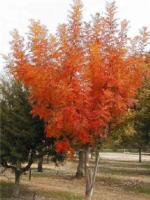
Chinese pistache (Pistacia chinensis) – Deciduous, 30-50', slow growing, pest free, tolerates heat, drought and poor soil, resistant to oak root fungus, fall color (yellow-orange to orange-red).
Red horse chestnut (Aesculus carnea) – Deciduous, 30-50', moderate growth, needs water, best in sheltered, cooler areas, flowers attract butterflies and humming birds.
Chitalpa (Catalpa x Chilopsis) – Deciduous, 35', fast growing, hardy, drought tolerant, tolerates most soils, spectacular summer flowers (pink to violet).
Idaho locust (Robinia ambigua) – Deciduous, 40', moderate growth, hardy, tolerates drought and poor soils, showy deep pink flowers spring to summer.
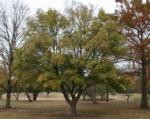

LARGE SHADE TREES
Beauty without the fuss; our selection of low maintenance shade trees for Lake County leaves you time to actually enjoy that shade! These trees grow 40 feet tall or more.
Valley oak (Quercus lobata) pictured right – Deciduous, 60-75' in deep soil,
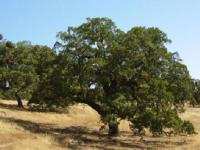
Red oak (Quercus rubra) – Deciduous, up to 75’, fast growing, deer resistant, drought resistant, beautiful fall color (red, orange or russet),
Zelkova elm (Zelkova serrata) – Deciduous, 60-80', moderate growth, tolerates drought once established and most soils, fall color (gold-bronze).
Norway maple (Acer platanoides) – Deciduous, 60', fast growing, tolerates most soils, leaves easily scorched in dry heat, roots can be invasive, tolerates placement in lawns.
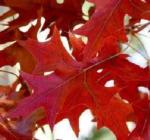
American (white) ash (Fraxinus americana) – Deciduous, 80' , fast growing, hardy, needs some water, tolerates placement in lawns, fall color (yellow to purple shades).
Maidenhair tree (Gingko biloba) pictured left– Deciduous, 45', fast growing, tolerates most soils, deer resistant, resistant to oak root fungus, good lawn
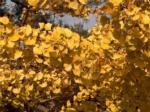
Catalpa (Catalpa speciosa) – Deciduous, 40-70', moderate/fast growing, tolerates hot, dry conditions, showy white summer flowers.
Japanese pagoda tree (Sophora japonica) – Deciduous, 50-75', fast growing, tolerates heat and drought, likes some shade, yellow summer flowers.
Paradox walnut (Juglans hindsii x Juglans regia) – Deciduous, 40’, fast growing hardwood tree, wide canopy, sterile hybrid between western Black walnut and English walnut developed by Luther Burbank.
LOW MAINTANECE FRUIT AND NUT TREES 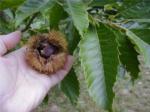
Chestnut
Chestnuts have traditionally been grown in the Tuscan highlands in Italy as a main carbohydrate source of the native people, and were consumed in place of cereal grains for at least half of the year.
Pomegranate


Persimmon
Revered by the Greeks as "fruit of the gods," which is the translation of its botanical name, persimmons are one of the few fruits that benefit from freezing. In parts of China they are left to freeze outside to speed up the ripening process.
Fig
Figs are one of the first crops cultivated by humans, before the domestication of wheat, barley and legumes, and have been an important food crop for thousands of years. Although commonly referred to as a fruit, the fig fruit is actually the flower of the tree, known as an inflorescence (an arrangement of multiple flowers), a false fruit or multiple fruit, in which the flowers and seeds
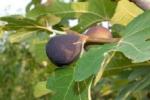
The fig flower is not visible as it blooms inside the fruit. The small orifice visible in the middle of the fruit is a narrow passage. Most fig varieties are parthenocarpic, meaning they don’t require pollination to produce fruit. If you choose a Smyrna fig it must be cross-pollinated with the capnfig which hosts a small wasp to transfer the pollen.
TREES TO AVOID IN LAKE COUNTY
Blue gum eucalyptus (Eucalyptus globulus) - produces a huge amount of litter, branches are brittle, roots are invasive, trees can pose fire hazard, can be invasive.
Red gum eucalyptus (Eucalyptus camaldulensis) - same as above, not frost tolerant, nicknamed “widow maker” for its extremely brittle branches.
California sycamore (Platanus racemosa) - branches are brittle, leaf hairs cause allergies.
Acacia spp. - short lived, brittle branches, produces lots of litter, major allergen, reseeds profusely.
Evergreen ash (Fraxinus uhdei) - high maintenance (needs pruning), messy leaf drop.
Honey locust (Gleditsia triacanthus) - brittle branches, long thorns.
Mayten (Maytenus boaria) - roots sucker and may invade nearby moister areas.
Melaleuca spp. - potentially invasive in moist soils.
Monterey cypress (Cupressus macrocarpa) - invasive root system, host for many problem insects and diseases that spread to other plants.
Monterey pine (Pinus radiata) - prone to many diseases in Lake County.
Leyland cypress (Cupressocyparis leylandii) - prone to many diseases in Lake County.
Giant sequoia (Sequoiadendron giganteum) - prone to disease in Lake County.
Tulip tree (Liriodendron tulipifera) - no tolerance to drought or highly alkaline soils.
Birch (Betula spp.) – needs lots of moisture, short lived in hot areas.
White alder (Alnus rhombifolia) - needs lots of moisture, short lived.
Modesto ash (Fraxinus glabra) - disease (especially anthracnose) prone in Lake County.
Tree-of-heaven (Ailanthus altissima) - extremely invasive species.
Elm (Ulmus spp.except Chinese and Zelkova elms) - prone to Dutch elm disease.
Fruitless mulberry (Morus alba) - roots are shallow and invasive and get into sewer lines or wells and destroy sidewalks.
Monterey Cypress*
Leiland Cypress*
*We don't recommend planting any cypresses in Lake County, as all of them are highly susceptible to cypress canker, which is frequently already present on trees when they are acquired from the nursery.
Compiled by UC Master Gardener Gabriele ONeill and UCCE Forest Advisor Gregory Giusti

